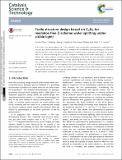Files in this item
Facile structure design based on C3N4 for mediator-free Z-scheme water splitting under visible light
Item metadata
| dc.contributor.author | Zhao, Guixia | |
| dc.contributor.author | Huang, Xiubing | |
| dc.contributor.author | Fina, Federica | |
| dc.contributor.author | Zhang, Guan | |
| dc.contributor.author | Irvine, John Thomas Sirr | |
| dc.date.accessioned | 2015-06-03T10:40:03Z | |
| dc.date.available | 2015-06-03T10:40:03Z | |
| dc.date.issued | 2015-06-01 | |
| dc.identifier | 185547398 | |
| dc.identifier | 61d7006f-468a-4d0d-b59f-940386ba129d | |
| dc.identifier | 000355487900040 | |
| dc.identifier | 84930614188 | |
| dc.identifier.citation | Zhao , G , Huang , X , Fina , F , Zhang , G & Irvine , J T S 2015 , ' Facile structure design based on C 3 N 4 for mediator-free Z-scheme water splitting under visible light ' , Catalysis Science & Technology , vol. 5 , no. 6 , pp. 3416-3422 . https://doi.org/10.1039/C5CY00379B | en |
| dc.identifier.issn | 2044-4753 | |
| dc.identifier.other | ORCID: /0000-0003-2594-350X/work/31324733 | |
| dc.identifier.other | ORCID: /0000-0002-8394-3359/work/68280538 | |
| dc.identifier.uri | https://hdl.handle.net/10023/6738 | |
| dc.description | The authors thank the Engineering and Physical Sciences Research Council (EPSRC) platform grant EP/K006800/1, EP/K036769/1 and EP/K022237/1 for financial support. | en |
| dc.description.abstract | In this work, two photocatalysts (i.e., C3N4 and WO3) were successfully combined into a heterojunction structure by a facile hydrothermal method for mediator-free overall water splitting, analogous to the natural photosynthesis over a two-step photoexcitation Z-scheme system. Hydrogen and oxygen are evolved with a 2 : 1 ratio by irradiating the C3N4-WO3 composites loaded with Pt under visible light (λ > 420 nm) without any redox mediator. Introducing reduced graphene oxide (rGO) into the C3N4-WO3 composites enhances the water splitting efficiency. Through optimizing the mass ratio in the C3N4-WO3 composites, rGO content, amount of loaded Pt and pH value of the reacting system, the highest H2/O2 evolution rates of 2.84 and 1.46 μmol h−1 can be obtained, with a quantum yield of 0.9%. Our findings demonstrate that the hydrothermal method is a promising strategy for constructing intimate heterostructures for Z-scheme water-splitting systems without using any redox mediator, and that rGO can be used to further enhance the performance in optimized conditions. | |
| dc.format.extent | 2890104 | |
| dc.language.iso | eng | |
| dc.relation.ispartof | Catalysis Science & Technology | en |
| dc.subject | QD Chemistry | en |
| dc.subject | NDAS | en |
| dc.subject | SDG 7 - Affordable and Clean Energy | en |
| dc.subject.lcc | QD | en |
| dc.title | Facile structure design based on C3N4 for mediator-free Z-scheme water splitting under visible light | en |
| dc.type | Journal article | en |
| dc.contributor.sponsor | EPSRC | en |
| dc.contributor.sponsor | EPSRC | en |
| dc.contributor.sponsor | EPSRC | en |
| dc.contributor.sponsor | EPSRC | en |
| dc.contributor.institution | University of St Andrews. School of Chemistry | en |
| dc.contributor.institution | University of St Andrews. EaSTCHEM | en |
| dc.identifier.doi | 10.1039/C5CY00379B | |
| dc.description.status | Peer reviewed | en |
| dc.identifier.url | http://www.rsc.org/suppdata/c5/cy/c5cy00379b/c5cy00379b1.pdf | en |
| dc.identifier.grantnumber | EP/K022237/1 | en |
| dc.identifier.grantnumber | EP/K036769/1 | en |
| dc.identifier.grantnumber | EP/K015540/1 | en |
| dc.identifier.grantnumber | EP/I022570/1 | en |
This item appears in the following Collection(s)
Items in the St Andrews Research Repository are protected by copyright, with all rights reserved, unless otherwise indicated.

